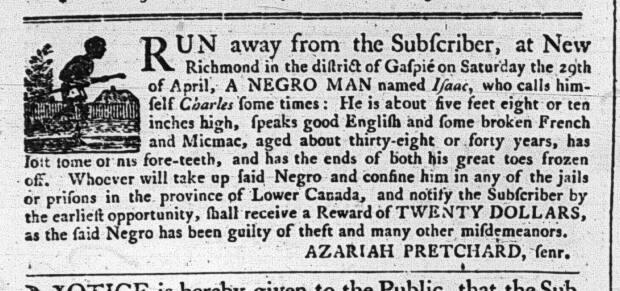Samuel L. Jackson's Enslaved and the lost history of Canadian slavery
Samuel L. Jackson's Enslaved describes itself as a series that "sheds new light on 400 years of human trafficking from Africa to the New World," but it's far from the only recent project focusing on the transatlantic slave trade.
In fact, it's not even the first this month.
The Ethan Hawke-led series The Good Lord Bird, which tells the story of abolitionist John Brown, premiered in early October. Filming wrapped on Barry Jenkins's upcoming series The Underground Railroad a week earlier, and the plantation-set horror film Antebellum came out in late August.
Still, Enslaved director Simcha Jacobovici says the reason he started the project, which looks at how the slave trade affected countries and people around the world, is because that history still isn't widely known. The population's understanding of these events are simplified and skewed, he said, and television could be a good way to fix that.
"People, when they think of slavery — especially in North America — they think of the American South plantations, the American Civil War," Jacobovici said.
That's an issue, he said, as the impacts extend far beyond the United States. But as popular culture tries more and more to address the international tragedy that is the slave trade, it is still far from accurately portraying that history onscreen — especially when it comes to Canada.
Slavery onscreen
Whether slavery is comprehensively shown on screen matters for more than just ratings. Charmaine Nelson, a historian and professor at the Nova Scotia College of Art and Design, says for most people, knowledge about slavery begins with movies like Amistad, Roots and 12 Years a Slave. And due to a lack of inclusion in schools, that's usually where their education ends, Nelson says.
"Almost all of the big-budget Hollywood films that have been produced about slavery are about slavery in the tropics … or the American South," she said.
And when such project do touch on Canada's involvement, it's almost always in one way: as the end of the Underground Railroad, Nelson says. 12 Years a Slave features Brad Pitt as the Canadian opponent to slavery; Harriet casts the country as a utopian land of freedom.

It is a trope that Enslaved follows: in the episode of the docuseries that takes place in Canada, the show features abolitionists, sympathizers and a ship that ferried enslaved Black Americans to freedom.
That ignores the previous centuries where slavery was legal — and practiced — here, Nelson said. Though those stories are important and true, the Underground Railroad lasted for a relatively short time compared to a much darker history of slavery in Canada. And the emphasis on that period over the other means the majority of Canadians have no idea it ever existed here, she said.
"We've enshrined 30 years and painted ourselves as only good abolitionists who saved Black Americans," Nelson said. "And we've totally obliterated, ignored and tried to raze 200 years when we were also slaving."
That was true for Tanisha Campbell, a Bishop's University student who has pushed for more Black history in Canadian elementary and high school curricula. She said that she had never been taught about slavery in school, and so had to direct her learning herself as a teenager.
Even so, she only recently learned about the history of slavery in this country.
"I thought it was the place of sanctuary, salvation," Campbell said. "People fled the States to come here and were safe. I had no idea that Canada had any part in it."
Slavery in Canada
That 200-year history took place in a window prior to 1833, when the Slavery Abolition Act ended the practice in most British colonies, including Canada. Prior to that, the 1793 Act to Limit Slavery allowed any enslaved person who reached Upper Canada to gain their freedom.
Though that was the first legislation in a British colony to limit slavery, it recognized the practice as legal and socially acceptable. Britain had introduced legal protection to slavery in its colonies as a way to encourage settlement, and even those who were freed were often required to work as indentured servants.
Those are the stories Nelson said she is interested in studying. She was recently named Canada Research Chair in Transatlantic Black Diasporic Art and Community Engagement, and through that role is establishing the Institute for the Study of Canadian Slavery. Based in Halifax, it will be the first such research institute in the country.
Nelson is also one of the few academics to operate in that field. That, she explained, is part of the problem: due to so few researchers looking at slavery in Canada, very few detailed studies about it are on the books. She herself studies Canadian fugitive slave ads, which were advertisements printed by slave owners hunting for enslaved people who had escaped.
Nelson says she is one of only two people studying them, and began only a few years ago.

"This study of ads has been going on since the 1970s in the USA, Brazil and Jamaica," Nelson said. "Do you get me? We are 50 years behind other nations in some of these types of study."
That is important because, without the research, movies and shows like Enslaved won't be able to accurately portray that history. And without that portrayal, Nelson said, Canadians will continue to see certain events — such as the death of George Floyd — as something they're not.
"They think it's a 21st century or 20th century anomaly, and it's not," Nelson said. "When I see that, I see slavery."
For more stories about the experiences of Black Canadians — from anti-Black racism to success stories within the Black community — check out Being Black in Canada, a CBC project Black Canadians can be proud of. You can read more stories here.


